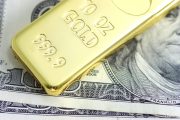
Once a sense of futility sets in, people just give up. This truth comes to mind when pondering our national debt, now a whopping $27 trillion. For unlike Harry Potter’s Voldemort, it today is hardly even alluded to, never mind named.
To put this number in perspective, 27 trillion one-dollar bills stacked up would reach to the moon and back more than three times. It’s perhaps so beyond comprehension that it’s also beyond conversation. That is, I’m old enough to remember when the Democrats and Republicans represented, respectively, fiscal laxity and fiscal responsibility.
Now the Democrats are still the party of taxing and spending, and the GOP is the party of not taxing and spending — which makes spending nation-rending.
Writing about this today, American Thinker’s Peter Skurkiss points out that “just 20 years ago in 2000 and 2001, the federal government ran budget surpluses of $236 billion and $127 billion, respectively.” Since then, the 2008 financial crisis and now the Pandemic™ have been used as a pretext to spend hand over fist (bailouts).
Do note here, however, “that the bulk of the bailout money always seems to go the top one or ten percent (banks, Wall Street, and the like) while the middle class get crumbs,” Skurkiss writes.
He then states that we should remember “that the more the politicians spend, the more of it that sticks to them. It’s an iron law just as is the Law Number One of real political science, which states that politicians take care of themselves and their families first and foremost.”
To understand this racket, imagine that you had a legalized counterfeiting operation (as the government does). This would be great for you and your cronies; you and they could spend your newly minted greenbacks before their circulation in the economy could apply inflationary pressure that drives up prices.
This is ultimately what happens, too. Increasing the number of dollars in society without a corresponding increase in actual wealth dilutes the dollar’s value; in other words, the cash in your wallet becomes worth less.
How extreme is the problem? Approximately 110 years ago, a dollar was worth 100 cents when valued against gold or silver. What’s its worth now?
Less than four cents.
Having more dollars chasing the same number of goods causes prices to rise. This badly affects the average Joe, who can’t just print up his own money. But it doesn’t matter to you with your greenback printing press.
You can create as much as you want.
Thus is money-supply expansion a hidden form of taxation that transfers wealth from the victims of legalized counterfeiting to its beneficiaries.
The national debt will be increased even more now under the Biden/Harris administration and a left-wing Congress. Moreover, our unfunded liabilities — things we’re obligated to pay for but can’t afford to cover — are projected to be $157 trillion in 2023, a $35 trillion increase from 2019 levels.
Furthermore, congressional “Democrats are even toying with adding fuel to the fire by adopting the cockamamie idea of Modern Monetary Theory (MMT),” Skurkiss points out. This basically states that for a monetarily sovereign country such as the United States that operates by a fiat currency it fully controls, how much you spend and go into debt are irrelevant.
(How to explain this thinking? Coming to mind is Upton Sinclair’s line, “It is difficult to get a man to understand something, when his salary depends on his not understanding it.”)
Yet “as politicians spend, spend, spend, not one of them addresses the question of how this debt will ever be discharged,” notes Skurkiss. “There’s a good reason for that: It’s because the debt can never be paid back, not by taxes or productivity increases.”
What does this bode for tomorrow? “There is no consensus on what is coming,” Skurkiss continues. “If one listens to independent analysts who are not hacks for the big banks, government, or Wall Street, a conflicting picture emerges. People like Jim Rickards, Doug Casey, and Richard Prechter of the Elliot Wave fame see a major depression coming, while Peter Schiff and others see runaway inflation in America’s future.”
Skurkiss suspects that the establishment may actually desire the dollar’s destruction so that a new currency can be introduced. None of this, of course, would benefit anyone but the establishment pseudo-elite.
Yet the street should still look in the mirror. As the following apocryphal (and, admittedly, well-worn) passage, incorrectly attributed to Scottish historian Alexander Tytler, warns:
A democracy is always temporary in nature; it simply cannot exist as a permanent form of government. A democracy will continue to exist up until the time that voters discover that they can vote themselves generous gifts from the public treasury. From that moment on, the majority always votes for the candidates who promise the most benefits from the public treasury, with the result that every democracy will finally collapse due to loose fiscal policy, which is always followed by a dictatorship.
This is especially true, and perhaps only true, when virtue diminishes in the people. Thus does lack of national morality lead to lack of money — and of liberty.




